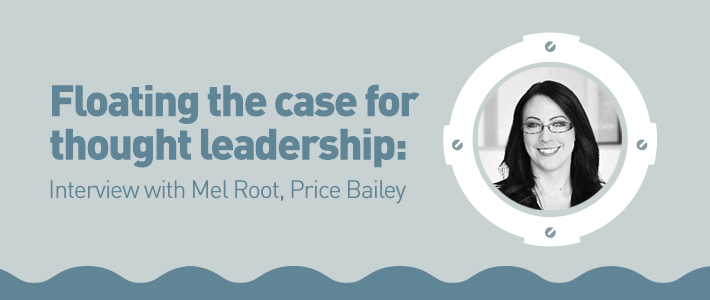In this instalment from our interview series on building the business case for thought leadership, we hear from Mel Root, Senior Marketing and Business Development Manager at Price Bailey, on how she attained approval and budget for their recent thought leadership programme.
How did you get your board to buy-in to your thought leadership programme?
The first thing I did was show the board the PwC [annual CEO survey] report, so I was benchmarking against best practice. I showed what they were doing and said while we’re not at that level and don’t want to operate in that space, we could learn from it. I also showed examples of thought leadership from companies I knew partners had worked at. That piqued interest because we’re all competitive!
What was the killer point that got them on board?
The examples I picked were good quality, even physically weighty so it was impressive in the hand. Previous reports we’d done were quite lightweight, so it was a good comparison and it felt like it was worth the money I was asking for. But the biggest thing was talking about ROI. The previous programme was based around an event and no one had spoken about ROI before. So I demonstrated how we would track ROI and how we would do more with the thought leadership than just hold an event. I showed a fully-planned idea of what we could do and how we’d continue relationships.
What advice do you have for others looking to get approval for a thought leadership programme?
Last year when selling-in I talked about low-hanging fruit and quick results. This year I went more long-term. I spoke about problems they’d told me that clients have and showed how we could respond to them with the stories the thought leadership could give us, especially through cross-selling.
I really spelled it out; I had a table that showed which services aligned with which story angles, and how I had a plan to sell it – that it’s not just some sort of pie in the sky piece of content we’d write and then forget about. Rather this is exactly what I’m going to try to achieve with this bit of content.
It also helped that we interviewed clients about last year’s report and have a video that shows clients talking about how fantastic the content was, so I can refer back to that feedback and say ‘let’s remember this and build on it’.
How do you get colleagues on board in production?
Even with the success, thought leadership can be seen as extra work for other teams. When boots are on the ground that’s the hardest thing to do, to get people to make the time to help us produce content. As a team we can’t really do everything ourselves, but we have shown them the quality of assets that we can produce and give them a byline for, and that’s helped.
This interview was taken from our guide, ‘How to get buy-in from the board for thought leadership’ .


